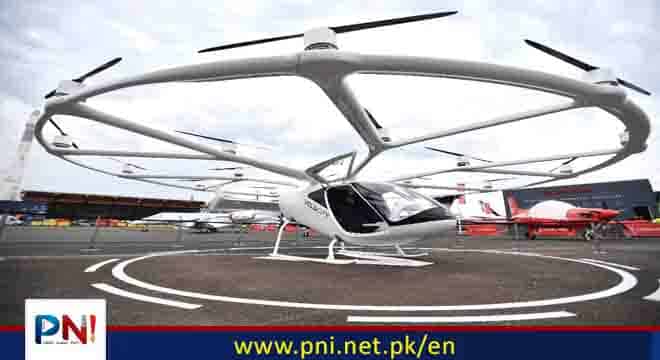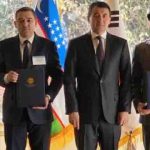Le Bourget, France, June 20 (AFP/APP): Barely making a buzz, a two-seat helicopter powered by an electric battery landed softly on the tarmac at the Paris Air Show after a 15-minute flight.
Such futuristic “flying taxis” are among the star turns of this year’s aerospace industry event as they move closer to the day when they can be used by the public.
For the VoloCity made by German firm Volocopter, the next stop is the 2024 Olympic Games in Paris, when it plans to ferry passengers across the French capital — more than a decade after its first test flight.
With a maximum airspeed of 110 kilometres (68 miles) per hour, the 18-rotor aircraft has room for a pilot and a passenger.
“The good news is (that) it’s very simple to fly. It has a very clever digital flight control system,” said VoloCity pilot Paul Stone, who used to test fighter jets for Britain’s Royal Navy.
Experienced helicopter and airplane pilots will be trained to fly the VoloCity, he said.
“The irony is for helicopter pilots, they will have to unlearn many very clever skills and learn to fly an aircraft simply again, because it’s much simpler to fly than, say, a helicopter,” Stone said.
Volocopter has been conducting test flights in the Paris region for more than a year as it preps for the Olympics.
The company has been working on the project with Groupe ADP, which operates Paris airports, state-owned metro and bus operator RATP, and the Ile-de-France region government.
ADP chief executive Edward Arkwright said more than 20 flights spanning 200 kilometres have taken place.
The air taxi will fly between Paris Charles de Gaulle Airport and nearby Paris-Le Bourget Airport as well as a heliport near Versailles and a “vertiport” installed on a barge in the Seine river in southeast Paris.
Ile-de-France president Valerie Pecresse said the region will spend one million euros to build the barge.
Volocopter is waiting for the greenlight from the European Union Aviation Safety Agency for permission to fly by spring 2024.
– ‘Not easy market’ –
Volocopter has ploughed $600 million into its air taxi — an expensive endeavour as it has yet to be made available to consumers.
“It’s a market not easy to enter, you have high investments,” said Christian Bauer, the company’s chief financial officer.
“It’s a challenge but we’re very close to the commercial phase,” he said.
The company has already received 300 pre-orders from private firms for its eVTOL (electric vertical take-off and landing) aircraft.
In addition to selling aircraft, Volocopter will manage the routes with an app that will enable online reservations.
Whether on not eVTOL aircraft become as easy to take as an Uber is an open question, but the aerospace industry is taking their potential impact seriously and for the first time they have their own dedicated space at the airshow.
Investment hasn’t been lacking. A recent study by the Deloitte consultancy found the sector attracted 6 billion euros in investment in 2021, before falling to 2.7 billion in 2022 after the pandemic hit.
“Four years ago it was still a very experimental sector. The market has consolidated a bit and today we have real prototypes and it is becoming a reality,” said Jean-Louis Rassineux, a senior partner at Deloitte responsible for the aerospace and defence sectors.
Orders are starting to flow in.
On Monday, the French startup Ascendance Flight Technologies announced another 110 orders for its Atea eVTOL, taking the total to 505.
The US firm Archer has 100 orders for its eVTOL by United Airlines worth more than a billion dollars which will be used as electric air taxis ferrying people from O’Hare International Airport and downtown Chicago.
Its Midnight eVTOL, can carry four passengers in addition to a pilot.
“Midnight is a convenient product which can take you from the airport to city centre for a cost that is similar to a ride share in an Uber … it can replace a ninety-minute commute by a five-minute commute,” Archer’s chief executive Adam Goldstein told AFP.
An Uber ride from Charles de Gaulle airport in to central Paris typically costs around $40.
Electric motors help drastically reduce maintenance costs compared to regular helicopters, said Goldstein, who rejected the idea that air mobility should be reserved for the rich, a criticism often addressed at eVTOLs.
Less maintenance requirements not only reduce costs but allows for more flights per day, meaning the price for consumers is lower.
The major aircraft manufacturers are making sure they don’t miss out.
Boeing has ploughed money into US startup Wisk Aero, which is presenting an pilotless eVTOL at the airshow.
“If the autonomy doesn’t work: we fail,” said Wisk CEO Brian Yutko. “We don’t have a plan B trying to figure out how to have an optional pilot. This venture is absolutely committed to certify the first autonomous aircraft.”
Follow the PNI Facebook page for the latest news and updates.








